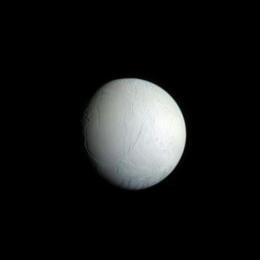Icy Oasis

| PIA Number | PIA10403 |
|---|---|
| Language |
|
With its excess warmth, water ice jets and huge vapor plume laced with simple organic materials, Enceladus is an important part of the quest to understand environments compatible with the chemistry of life as we know it. The sulci, or "tiger stripe" fractures, in the south polar region are visible at bottom -- the view here is parallel to the direction of the sulci.
The view looks toward the anti-Saturn hemisphere on the moon's trailing side. North on Enceladus (504 kilometers, or 313 miles across) is towards the top of the image.
This false-color view is a composite of individual frames obtained using filters sensitive to ultraviolet (centered at 338 nanometers), green (centered at 568 nanometers) and infrared light (centered at 1002 nanometers). The broad range of wavelengths exaggerates subtle color variations across the moon's surface.
The images were acquired with the Cassini spacecraft narrow-angle camera on May 11, 2008. The view was obtained at a distance of approximately 739,000 kilometers (459,000 miles) from Enceladus and at a Sun-Enceladus-spacecraft, or phase, angle of 36 degrees. Image scale is 4 kilometers (3 miles) per pixel.
The Cassini-Huygens mission is a cooperative project of NASA, the European Space Agency and the Italian Space Agency. The Jet Propulsion Laboratory, a division of the California Institute of Technology in Pasadena, manages the mission for NASA's Science Mission Directorate, Washington, D.C. The Cassini orbiter and its two onboard cameras were designed, developed and assembled at JPL. The imaging operations center is based at the Space Science Institute in Boulder, Colo.
For more information about the Cassini-Huygens mission visit http://saturn.jpl.nasa.gov . The Cassini imaging team homepage is at http://ciclops.org .
Credit: NASA/JPL/Space Science Institute
